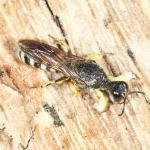Philanthus clypeata (THUNBERG, 1815); Crabro lapidaria (FABRICIUS, 1804) preocc.; Crabro nigridens (HERRICH-SCHAFFER, 1841); Sphex ovate (CHRIST, 1791); Crabro quadrifer (DUFOUR, 1841); Crabro vexilata (PANZER, 1797)
The males of this species have a striking appearance, with a greatly elongated head constricted behind the eyes to form a distinct, almost stalk-like, ‘neck’. The male’s fore metatarsus is also distinctive, being drawn out into a quadrate shield-shaped process. Females are less distinctive, closely resembling females of Ectemnius, although the gastral terga are more strongly punctate.
In Britain it has only ever been recorded from Weybridge in Surrey, and has not been seen there for over 150 years. The paucity of records and its early loss from Britain makes it difficult to assess its true status, but it is likely to have been a relatively short-lived colonist only, with a single record in 1848 and again in 1853 (Richards, 1980; Baldock, 2010). Given its relatively widespread occurrence in France, it is perhaps a little surprising that it has seemingly not been recorded from the Channel Islands.
It has a rather southern distribution within Europe, being very rare in Scandinavia (Lomholdt, 1984), but occurring across southern Europe, north Africa and into western and central Asia.
This species is listed as Extinct in Britain by Shirt (1987).
The species is likely to be found in a variety of habitats where suitable nesting sites are found. From Carrington (1886), is is apparent that the British locality was, in general terms, an area of open heath, scrub and woodland.
No data available from Britain. Dollfuss (1991) gives May to September for continental records.
Bitsch & Leclercq (1993) cite a number of European publications, where small adult Lepidoptera are listed as prey items.
In mainland Europe this species nests in galleries in old timber, including large, ancient timbers and posts as well as veteran trees. Janvier (1977) describes a nest in a dead branch of an oak tree, using old galleries of xylophagous insects, in which a curved gallery led into nine individual cells. Falk (1991) notes that the nest entrances are partly closed with mud.
No data available.
No data available.
2016


